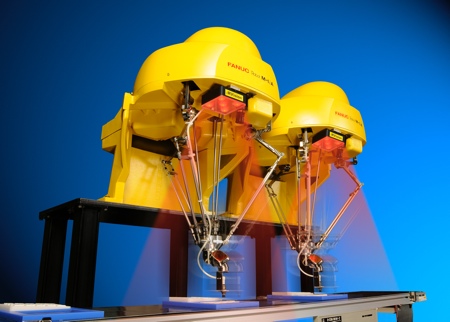The future certainly looks bright for robots in the pharmaceutical sector, according to Chris Sumner, Managing Director of FANUC. They have already found their way into the packaging process and, as the sector becomes more comfortable with robot technology and begins to integrate it into legacy systems, new applications are now starting to be found throughout the pharmaceutical manufacturing process.
FANUC has identified some typical application areas, which include palletising, packaging and pick & place, as well as machine tending. Although not currently well used in the pharma sector, there is also a growing trend towards the use of delta robots too, which are able to offer a very high-speed picking solution for small parts.
Merck, for example, has successfully employed a FANUC M-1iA delta robot on a bottling line to place dispenser caps onto bottled allergy medications. The M-1iA is capable of operating at 120 cycles per second. Ten variants of the bottle can be run on the system and the only robot line change requirement is to select the appropriate programme on the robot controller.
A vision solution is vital in many pharmaceutical applications to enable inspection, position and orientation capabilities. Where products are picked from conveyors by a robot, the addition of robot vision is essential to ensure fast and precise handling and packaging. Additionally, barcode reading and visual quality control can be incorporated to further streamline and accelerate production capabilities.
FANUC’s iRVision is an integrated solution, consisting of both software and hardware, which can add easy-to-use vision capabilities to an application. Because the vision solution is integrated into the robot controller no third-party software is needed. Vision solutions from FANUC include iRVision 2D which includes part location, barcode reading and anti-defect checking and iRPickTool for picking and placing from/to conveyors.

iRVision from FANUC: adding sight to a robot is vital in many pharmaceutical applications to enable inspection, position and orientation capabilities
One recent scenario saw a six axis LR Mate200iB incorporating iRVision and line tracking, locate glass and plastic syringes on a circulating infeed conveyor, pick them and place them into blisters on an integrated blister machine ready for secondary packaging. The custom vacuum-style end-of-arm tool is designed to gently press the syringe into a locking tab in the blister without shattering the glass syringe.
The pharmaceutical sector largely depends on automated process-control and quality-assurance systems to ensure that every batch is identical to the previous one. In addition, the requirement for pharmaceutical packaging to carry identical labels can be streamlined through the use of robot vision and barcode scanners which help speed up throughput, automating the task of comparing the labels on incoming products with an original, master copy.
There is also a growing requirement to monitor and record every step of the production process. These traceability requirements – combined with the need for labelling and traceability right down to the individual product – will almost certainly benefit from an automated solution which can ensure accuracy, continuity and reliability.
Meeting demands
Today’s robot offerings are able to meet demanding pharmaceutical requirements. In the laboratory environment robots can now safely replace human operators undertaking sterile manufacturing processes, where there may be a contamination risk. In one laboratory application a FANUC M16iB was chosen for its reliability and speed to create a single point handling solution for vial processing. A handling tool was designed and attached to the end of the robot to enable it to handle ten vials at a time. A variety of components were also placed around the robot cell – including indexing tables for full rack staging, a thermostatically controlled water bath for precise sample temperature, a retrieval system for dumped vials, a washing-brushing-rinsing-drying station, a preservative spray station, and a recapping station.
In applications that require additional components within the cell, FANUC controllers can offer benefits. A single, compact, FANUC R-30iB controller, the company’s latest robot controller, is able to control up to four robot arms and numerous additional axes, from a single CPU, with only the addition of control boxes to house the servo amplifiers and power components. This could allow for the use of more flexible and adaptable servo grippers in place of pneumatic grippers, which can help to future-proof gripping requirements. The ability to control additional axes also allows the robot to be placed on a linear rail, for example, if it needs to cover a wide work envelope, offering a good solution for end of line packaging applications.
FANUC has developed its controller software tools to simplify and standardise the programming, setup and operation of the robot. Depending on the end-user application, the controller can be supplied with one of several application tools for simple consistent robot programming, set-up and operation. In addition, more than 250 software options are available to add further functionality.

Chris Sumner, Managing Director FANUC UK and Vice President of FEC
Making a cell safe can represent a considerable percentage of the total setup cost. FANUC has addressed this issue with a variety of safety solutions to ensure that all safety requirements are met in a cost-effect way with minimal hardware requirements. Its Dual Check Safety (DCS) software options include position and speed check functionality, which allows for the creation of safety zones that the robot is not allowed to enter or leave. It can also be applied to speed, ensuring that the robot does not exceed a set speed in certain areas of the cell, thus ensuring both product and human safety.
A particularly useful software option is the safety DCS PMC (programmable machine control) which, in effect, offers an in-built safety PLC option. Instead of specifying a separate PLC to control the system this software option makes it possible for the controller to manage all the components surrounding the robot, including the safety requirements helping to simplify control and negate the need for additional control hardware, such as PLCs.
A bright future?
Justification for the use of robots in the pharmaceutical industry is wide-ranging – from better worker safety to improved overall product quality. Speeding up the drug discovery process could be yet another benefit, helping industry to meet the ever-increasing call for new drugs to treat the world’s growing ageing population. Robots have already shown that they can improve productivity and efficiency in many industries and the pharmaceutical industry is now starting to make use of these abilities too.




